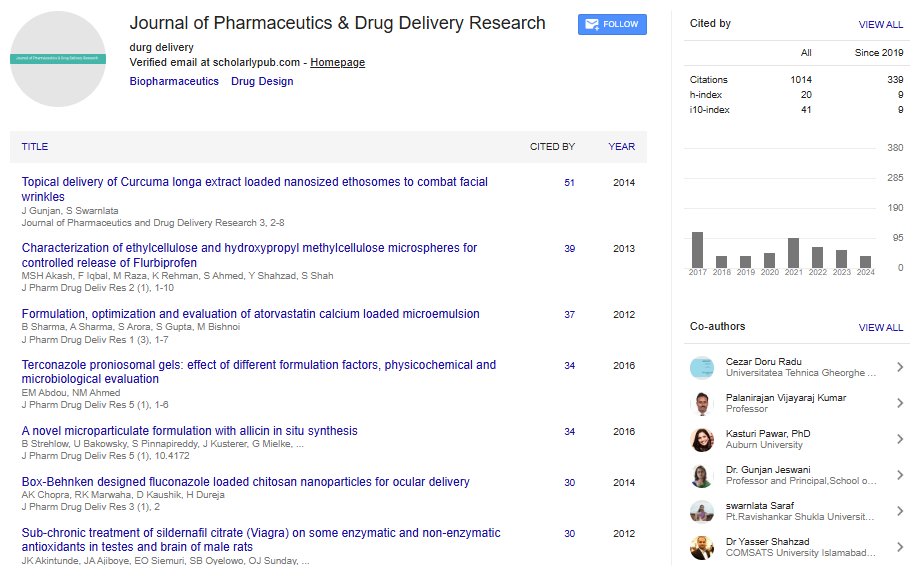Opinion Article, J Pharm Drug Deliv Res Vol: 13 Issue: 5
Drug Targeting: Revolutionizing Precision in Therapeutic Delivery
Ziyue Zhong*
1Department of Pharmacy, The University of Texas at Austin, Austin, USA
*Corresponding Author: Ziyue Zhong,
Department of Pharmacy, The University
of Texas at Austin, Austin, USA
E-mail: zhongz386@gmail.com
Received date: 26 August, 2024, Manuscript No. JPDDR-24-151937;
Editor assigned date: 28 August, 2024, PreQC No. JPDDR-24-151937 (PQ);
Reviewed date: 11 September, 2024, QC No. JPDDR-24-151937;
Revised date: 18 September, 2024, Manuscript No. JPDDR-24-151937 (R);
Published date: 26 September, 2024, DOI: 10.4172/2325-9604.1000303
Citation: Zhong Z (2024) Drug Targeting: Revolutionizing Precision in Therapeutic Delivery. J Pharm Drug Deliv Res 13:5.
Description
Drug targeting represents an innovative approach in modern pharmacology, aiming to deliver therapeutic agents directly to specific cells, tissues, or organs within the body. This precision strategy minimizes systemic side effects and enhances the efficacy of treatments, especially in conditions like cancer, infectious diseases and autoimmune disorders where traditional drug delivery methods often lead to undesirable toxicity. The concept of drug targeting leverages advances in molecular biology, nanotechnology and biochemistry to create “smart” delivery systems that interact with cellular receptors or specific molecular markers within the body.
This approach utilizes ligands such as antibodies, peptides, or small molecules that bind to specific receptors on the surface of target cells. By attaching these ligands to drug molecules or drug carriers (such as nanoparticles or liposomes), active targeting ensures that the drug is concentrated at the intended site, sparing healthy tissues. Passive targeting is particularly relevant in tumors and inflamed tissues where vascular permeability is enhanced, allowing nanoparticles and other large drug molecules to accumulate in these areas more readily. Known as the Enhanced Permeability and Retention (EPR) effect, this mechanism is commonly used in cancer therapies, where traditional drugs might otherwise harm healthy cells. This strategy involves external forces to direct drugs to specific areas. For example, magnetic nanoparticles can be steered to specific sites in the body using external magnetic fields, while ultrasound or heat-sensitive carriers release their contents upon exposure to focused ultrasound waves or heat.
Drug targeting often employs sophisticated carriers, including liposomes, nanoparticles, micelles and dendrimers, to encapsulate the drug, protect it from degradation and improve its absorption by target cells. Carriers can be customized to release the drug in response to stimuli like pH changes, enzymes, or temperature variations specific to the target environment.
Nanoparticles are particularly effective due to their small size, which enables them to navigate through biological barriers and interact with cellular structures. Liposomes, on the other hand, mimic cell membranes and can merge with the target cell to release the drug intracellularly. These carriers not only optimize drug delivery but also reduce the risk of adverse effects by limiting drug interaction with non-target tissues.
One of the most promising applications of drug targeting is in cancer therapy. By delivering chemotherapy drugs specifically to tumor cells, drug targeting reduces damage to healthy cells and mitigates severe side effects like nausea, hair loss and immunosuppression. Similarly, drug targeting is being discovered in neurological disorders to bypass the blood-brain barrier, a selective barrier that prevents many drugs from reaching the brain. This holds potential for treating diseases like Alzheimer’s and Parkinson’s, where current treatment options are limited.
In the field of antibiotics, drug targeting can address bacterial infections that have developed resistance to traditional antibiotics. By focusing the antibiotic’s action specifically on bacterial cells while sparing human cells, drug targeting can combat infections more effectively and minimize resistance development.
Despite its promise, drug targeting faces challenges in biocompatibility, target specificity and manufacturing scalability. Designing carriers that are safe and non-toxic is complex, especially as drug targeting systems often require complicated chemical modifications. Target specificity also remains an obstacle, as some receptors targeted by drugs can be present in multiple cell types, risking unintended interactions. Additionally, scaling up production of targeted drug delivery systems involves regulatory, technical and financial challenges that require further innovation.
Future developments in genomics, proteomics and artificial intelligence could help overcome these footraces by identifying unique molecular markers for different diseases and designing drug targeting systems more precisely. Advances in bioinformatics will also aid in predicting how different drugs interact with biological systems, making it possible to customize drug targeting on a patient-by-patient basis.
Conclusion
Drug targeting is transforming how we approach treatment, ushering in an era of precision medicine that maximizes therapeutic benefits while minimizing side effects. As research and technology evolve, drug targeting has the potential to redefine standards of care across many medical fields, making treatments safer, more effective and tailored to individual patient needs. This innovative approach not only enhances patient outcomes but also opens new opportunities for treating previously intractable diseases, marking a significant leap forward in the quest for personalized medicine.
 Spanish
Spanish  Chinese
Chinese  Russian
Russian  German
German  French
French  Japanese
Japanese  Portuguese
Portuguese  Hindi
Hindi 
